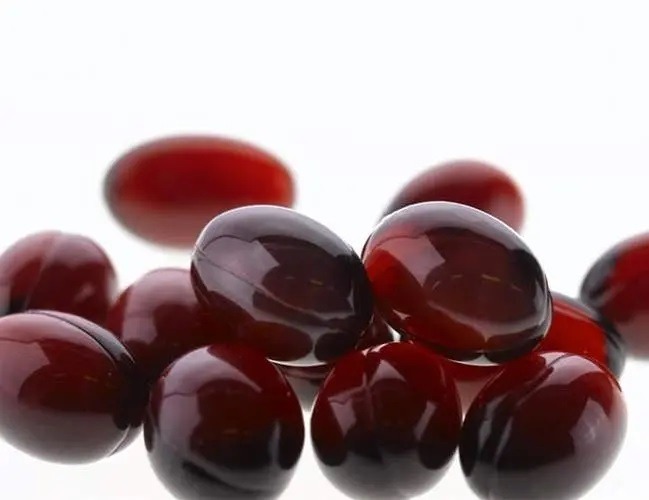With its transmembrane antioxidant capacity and photo-damage repair properties, astaxanthin demonstrates unique advantages in skin sun protection and repair. It not only synergistically enhances the efficacy of traditional sunscreens but also reduces ultraviolet (UV)-induced oxidative stress and inflammatory damage at the source, achieving “prevention + repair” dual protection. Below is a detailed analysis of its mechanisms and applications:
- Sun Protection Mechanisms of Astaxanthin
(1) UV Absorption to Reduce Light Penetration
– Broad-Spectrum Absorption: Astaxanthin’s molecular structure absorbs UVA (320–400 nm) and partial UVB (280–320 nm), reducing direct UV damage to the skin (notably effective against UVA).
– Synergistic Enhancement: When combined with physical sunscreens (e.g., zinc oxide), it fills spectral gaps in physical UV filters, boosting overall sun protection factors (SPF/PA values).
(2) Inhibition of Photo-Oxidative Stress
– Free Radical Scavenging: UV irradiation generates reactive oxygen species (ROS). Astaxanthin, with 800× higher antioxidant capacity than coenzyme Q10, rapidly neutralizes singlet oxygen (¹O₂), superoxide anions (O₂⁻), and other radicals, blocking the “oxidative cascade.”
– Protection of Critical Molecules:
– DNA: Reduces UV-induced thymine dimer formation, lowering mutation risks.
– Collagen: Inhibits matrix metalloproteinases (MMP-1/MMP-3) activity, preventing collagen degradation and maintaining skin elasticity.
(3) Anti-Inflammatory and Immunomodulatory Effects
– Suppression of Inflammatory Pathways: Downregulates NF-κB and MAPK signaling pathways, reducing pro-inflammatory cytokines (e.g., IL-6, TNF-α) to alleviate post-sun erythema and burning.
– Langerhans Cell Protection: Preserves skin immune cell function, mitigating UV-induced immunosuppression.
- Post-Sun Repair Mechanisms
(1) Photodamage Repair
– Accelerated DNA Repair: Activates the nucleotide excision repair (NER) system to promote DNA recovery.
– Reduced Lipofuscin Deposition: Inhibits UV-induced melanogenesis enzymes (e.g., tyrosinase), preventing hyperpigmentation.
(2) Barrier Restoration
– Enhanced Stratum Corneum Hydration: Stimulates filaggrin and ceramide synthesis, repairing the epidermal barrier and reducing transepidermal water loss (TEWL).
– Microbiome Regulation: Suppresses harmful bacteria (e.g., *Cutibacterium acnes*), alleviating post-sun sensitivity and acne flare-ups.
(3) Anti-Photoaging
– Reversal of Photoaging Markers: Clinical trials show that topical 0.1% astaxanthin emulsion for 8 weeks reduces wrinkle depth by 15% and improves skin elasticity by 20% (*Journal of Dermatological Science*, 2019).
– Collagen Stimulation: Activates the TGF-β/Smad pathway to boost type I collagen synthesis.
- Clinical Evidence
– Sun Protection:
A human trial demonstrated that oral astaxanthin (6 mg/day) combined with sunscreen reduced UV-induced erythema by 50% (vs. 30% with sunscreen alone).
– Repair Efficiency:
Post-sun astaxanthin gel reduced IL-1β levels by 40% within 24 hours and accelerated epidermal repair by 1.5× in 48 hours.
- Application Strategies
(1) Sun Protection Enhancement
– Oral + Topical Combination:
– Oral: 4–6 mg/day (post-meal) for systemic photoprotection.
– Topical: Sunscreen with 0.05–0.1% astaxanthin (lipid-encapsulated for better penetration).
– Formula Example:
Physical sunscreen (zinc oxide + titanium dioxide) + astaxanthin oil-soluble extract + vitamin E to enhance UVA protection and longevity.
(2) Post-Sun Repair
– Immediate Soothing: Gel with 0.1% astaxanthin, centella asiatica extract, and panthenol for rapid cooling and redness reduction.
– Long-Term Recovery: Nighttime serum with 0.2% astaxanthin + ceramides + hyaluronic acid to restore the skin barrier.
(3) Anti-Photoaging Routine
– Daily Skincare: Morning serum (astaxanthin + vitamin C derivatives) paired with night cream (astaxanthin + retinol) for 24-hour protection.
- Synergistic Combinations
– Vitamins C/E: Regenerate oxidized astaxanthin, forming an antioxidant network.
– Niacinamide (B3): Inhibits melanin transfer to reduce sunspots.
– Ectoin: Enhances UV-damaged protein repair.
– Bisabolol: Amplifies anti-inflammatory effects.
- Safety & Precautions
– Photostability: Astaxanthin is light-resistant but requires dark packaging to prevent oxidation.
– Side Effects: Topical use >0.2% may cause temporary orange discoloration; recommend nighttime use or dilution.
– Contraindications: Caution for shellfish allergies (low allergenicity in *Haematococcus pluvialis*-derived astaxanthin).
- Future Directions
– Nanocarriers: Lipid or microencapsulation to improve skin penetration.
– Bioengineered Production: High-purity astaxanthin via yeast fermentation to reduce costs and algal contamination risks.
– Smart Delivery Systems: pH- or temperature-responsive gels for targeted post-sun repair.
Astaxanthin’s value lies in its dual-action “inside-out” and “outside-in” approach:
– Externally: Physicochemical synergy to block UV penetration.
– Internally: Halts oxidative damage, repairs cellular structures, and rebuilds the skin barrier.
Its natural origin and multi-target mechanisms make it ideal for sensitive or photoaged skin, particularly when combined with traditional sunscreens for a comprehensive “active defense + deep repair” photoprotection system.


Leave A Comment